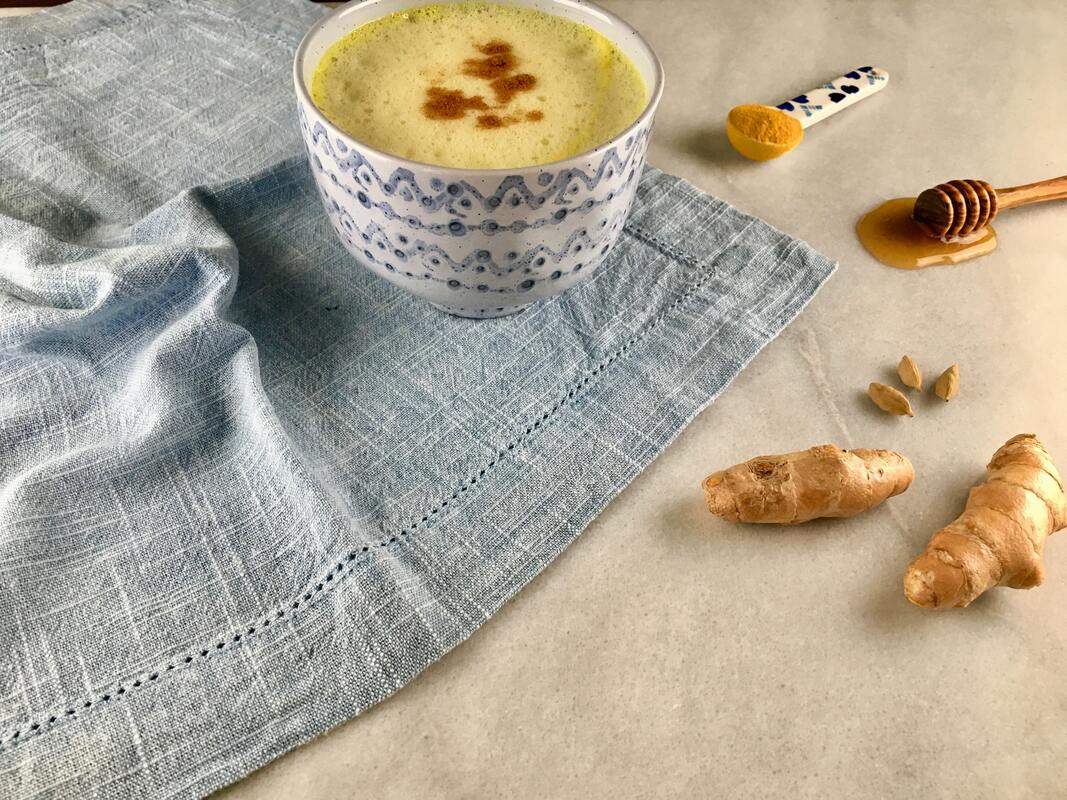|
Turmeric is a super food I consume often and you may want to consider it too. It has so many healthy therapeutic properties such as it being an antioxidant, anti-inflammatory, and assisting in lowering blood sugar and blood pressure, in addition to supporting the immune system. I consume it regularly because it also helps to ease muscle aches which helps for my recovery after doing tough exercise. You can consume turmeric in a number of ways, such as through a capsule supplement, if you are not fond of its earthy taste. But, I like to consume it in its most natural form such as turmeric root. The texture is very similar to ginger root which you can easily slice or grate as necessary for consumption. If turmeric root is hard to find for you, you can opt to just consume it in its ground form.
An easy way to consume turmeric is to blend into foods. I love it in curries, rice, soups and hummus. You can also easily just drink it too in a warm golden milk beverage or enjoy it for a meal replacement such as my Golden Milk Mango Protein Smoothie recipe. Looking for a savory option? Turmeric is also great in making a healthy spin on Mac & cheese. You can try my Vegan Mac & Cheese here. So you can see, using turmeric in cooking opens up lots of possibilities to get creative and also gives your dishes a nutritional boost. Eat Good, Look Good, Feel Good, Chef Vanessa
0 Comments
 Creating your own spice blends is something you want to have on hand as the possibilities are endless. I say this because, just about every cuisine has its own set of spices that is used frequently in dishes. For example, popular in Indian cuisine you will notice flavors of ginger,turmeric and cardamom. In Asian cuisine, warm spices are used sometimes in certain blends such as cinnamon, five spice powder and ginger. In Middle Eastern cuisine you'll taste flavors of cumin and sumac( a spice derived from deep red berries that are ground with the tartness and flavor profile of lemon.) and coriander. These are just examples, but you can get the general idea of how exciting the world of spices can be! When creating your own spice blends think of how you would like to use them. Will you use them strictly for meat or do you want it universal where you are adding your spice blend to jazz up your vegetables and side dishes? For instance, I like to keep spice rubs and blends on hand that I make with a flavor profile for a cuisine. Spice rubs generally have a little sugar added and are mostly used for coating protein so that when it is cooked, you end up with a nice crust that is filled with loads of flavor without much effort. With spice blends, the idea is the same, except minus the sugar. In reality you can create some really cool blends to fit YOUR taste buds. Some key things to remember when creating your own blends. 1. Don't overthink it. Keep it simple. A laundry list of spices and herbs are not necessarily better. 2. Think of a cuisine that you like and mimic those flavors in a rub or spice blend. 3. Make small batches. This is essential to getting the freshest taste possible, where you will use in a reasonable amount of time. Also keep a small notebook with measurements of your blend for later reference. 4. Use quality spices the most you can afford. Shop at international food stores, which will have the best pricing and variety. I shop at my local Indian, Asian & Caribbean stores in my neighborhood. If that's not an option for you, there are plenty of online resources. 5. Use "natural" quality salts such as sea salt, Himalayan pink salt or kosher salt. Adjust and taste as you create your special spice blend. 6. Keep your spice blends in glass jars with a tight lid to keep them fresh and away from direct light. 7. Looking for inspiration? Try my Star Arnise Spice Rubbed Chicken Recipe. You may be thinking, should I buy whole or ground spices?  When it comes to optimal flavor, whole spices that you grind will give you the best results. But, don't let that deter you from making a unique blend to call your own using ground spices. If you are using whole spices, such as peppercorns or cinnamon sticks the flavor can't be beat. If you want to go down this road for preparation, use something simple as a coffee grinder and dedicate this for making your spice blends. You'll notice in Indian cuisine, whole spices are used a lot and are often toasted first before grinding. Like nuts, toasting your whole spices will also give you optimal flavor. The key thing to remember with making your own spice blends is to just start cooking with them. Use them to your hearts desire using them on meat, seafood, veggies and soups. Lastly, if you make a special blend that you think is awesome, post a comment to share! Eat Good, Look Good, Feel Good! Chef Vanessa
(Some of the links in this post are affiliate links. This means if you click on the link and purchase the item, I will receive a commission at no extra cost to you. )  Drinking non dairy milks are a healthy addition to ANY diet. Lots of folks turn to it, because of a vegan lifestyle or others who simply can't tolerate too much dairy. I happen to be one of those folks, with a low intolerance to milk. I would notice I would have some digestive issues whenever I would drink cow's milk and even some milk which was supposedly "lactose free" I still would get ill effects from it. At first, I was not on board with drinking non dairy milks as I found out a lot of them lacked flavor, or were watered down versions from what you would get at your local grocery store. Now don't get me wrong, plant based milks have greatly improved over the years and there are some decent brands, but you WILL pay a good price for them. Also, when purchasing a plant based milk, a good amount of them still have some questionable ingredients you can't pronounce or need to google the information to find out what you are actually consuming. Although nuts can be on the expensive side, plant based milk can also be made with seeds and other plant based choices, such as hemp & sesame seeds, coconut, and oats. My favorite plant based milk is cashew milk that I make from scratch. Although, I like other varieties, cashew milk is my favorite for its creamy neutral taste, its not sweet and works well in my morning coffee or tea, smoothies and topping off my breakfast oatmeal. Additionally with making your own cashew milk, the upside also is that you do not have to strain after blending,unlike other nut milks like almond where you would need a nut bag to create a smooth texture. By not having to strain, you also retain more fiber in the finished milk. If you want to make your own delicious homemade cashew milk without preservatives, you can see how to make it here. Because raw cashews can be a little more on the pricier side than almonds, I purchase mine conveniently in bulk online, affordably at this resource. Once you make your own plant based dairy free milk and compare to commercial brands, you will notice the difference in taste and will be hooked! Eat Good, Feel Good, Look Good! Chef Vanessa Wow, this is the fourth week on healthy habits and this is a tough one! Reducing your sugar consumption. Now although, my title says switch over to natural alternatives, the rules are the same. We should strive to reduce sugar in our diets, regardless of the source. This was a real challenge for me, as I didn't realize how much sugar I was consuming as this stuff is lurking in LOTS of foods. Why should you be concerned with reducing your sugar consumption? Well, there are a host of reasons, but a few that will get your attention is that it can cause weight gain, can spike your blood sugar and insulin levels, which can cause you to lack energy. Also if you are experiencing joint pain, (as I was) it can worsen your symptoms. If you remember from a previous blog post, my recommendation is to reduce consuming highly processed food. One of the other reasons is because hidden sugars are in certain products such as granola bars, crackers, breakfast cereals, (yep it's there, even with so-called healthy cereals.) chips and processed meat and even BREAD! I'm keeping in mind, some of you may be in different levels of sugar addiction from low to high, but here are a few suggestions for reducing sugar consumption as painless as possible. If you are a soda drinker, switch over to sparkling flavored water with a splash of 100 percent natural fruit juice. Try doing this with half and half in portion. (You will get a hint of sugar, but you can easily cut your sugar consumption in half with this habit.) Eventually, your taste buds will adjust and you should be able to consume just the sparkling water without the need for the fruit juice. If you eat oatmeal but tend to have a heavy hand with maple syrup or brown sugar, (I was guilty of this.) try using a reduced amount of only a tablespoon. If it is still not sweet enough for you at first, try adding natural sweeteners of using frozen or fresh berries such as blueberries & strawberries or roasted apple, which has sweetness but also the benefits of added fiber and vitamins.  My final tip is to switch over from highly processed white sugar to natural alternatives. Although these suggestions are still sugar, they are less processed and have a few health benefits. Try switching over in limited amounts for natural sugar such as honey, maple syrup, date sugar (has fiber) and coconut sugar. Remember, this healthy habit can take a while, so be patient with yourself. Eat Good, Look Good, Feel Good! Chef Vanessa |
AuthorVanessa LaBranche Archives
June 2024
|




 RSS Feed
RSS Feed